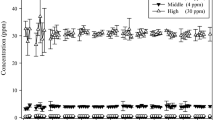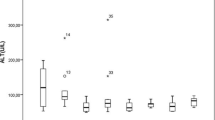Abstract
1,2-Dichloroethane (DCE) was reported to be carcinogenic in rats in a long-term bioassay using gavage in corn oil (24 and 48 mg/kg/day), but not by inhalation (up to 150–250 ppm, 7 h/day, 5 days/week). The daily dose metabolized was similar in the two experiments. In order to address this discrepancy, the genotoxicity of DCE was investigated in vivo under different exposure conditions. Female F-344 rats (183–188 g) were exposed to [1,2-14C]- DCE in a closed inhalation chamber to either a low, constant concentration (0.3 mg/l=80 ppm for 4 h) or to a peak concentration (up to 18 mg/l=4400 ppm) for a few minutes. After 12 h in the chamber, the dose metabolized under the two conditions was 34 mg/kg and 140 mg/kg. DNA was isolated from liver and lung and was purified to constant specific radioactivity. DNA was enzymatically hydrolyzed to the 3′-nucleotides which were separated by reverse phase HPLC. Most radioactivity eluted without detectable or with little optical density, indicating that the major part of the DNA radioactivity was due to covalent binding of the test compound. The level of DNA adducts was expressed in the dose-normalized units of the Covalent Binding Index, CBI = (μmol adduct per mol DNA nucleotide/mmol DCE per kg body wt. In liver DNA, the different exposure regimens resulted in markedly different CBI values of 1.8 and 69, for “constant-low” and “peak” DCE exposure levels. In the lung, the respective values were 0.9 and 31. It is concluded that the DNA damage by DCE depends upon the concentration-time profile and that the carcinogenic potency determined in the gavage study should not be used for low-level inhalation exposure.
Similar content being viewed by others
References
Arfellini G, Bartoli S, Colacci A, Mazzullo M, Galli MC, Prodi G, Grilli S (1984) In vivo and in vitro binding of 1,2-dibromoethane and 1,2-dichloroethane to macromolecules in rat and mouse organs. J Cancer Res Clin Oncol 108: 204–213
Bolt HM, Kappus H, Buchter A, Bolt W (1976) Disposition of [1,2-14C] vinyl chloride in the rat. Arch Toxicol 35: 153–162
Caviezel M, Lutz WK, Minini U, Schlatter C (1984) Interaction of estrone and estradiol with DNA and protein of liver and kidney in rat and hamster in vivo and in vitro. Arch Toxicol 55: 97–103
Hooper K, Gold LS, Ames BN (1980) The carcinogenic potency of ethylene dichloride in two animal bioassays: a comparison of inhalation and gavage studies. In: Ames B, Infante P, Reitz R (eds) Ethylene dichloride: a potential health risk? Banbury Report, vol 5, Cold Spring Harbor Laboratory, Cold Spring Harbor, NY, pp 65–81
Inskeep PB, Koga N, Cmarik JL, Guengerich FP (1986) Covalent binding of 1,2-dihaloalkanes to DNA and stability of the major DNA adduct, S-[2-(N7-guanyl)ethyl]glutathione. Cancer Res 46: 2839–2844
Lutz WK (1979) In vivo covalent binding of organic chemicals to DNA as a quantitative indicator in the process of chemical carcinogenesis. Mutat Res 65: 289–356
Lutz WK, Schlatter C (1978) A closed inhalation system for pharmaco kinetic and metabolism studies of volatile compounds with small laboratory animals. Arch Toxicol Suppl. 1: 373–375
Maltoni C, Valgimigli L, Scarnato C (1980) Long-term carcinogenic bioassays on ethylene dichloride administered by inhalation to rats and mice. In: Ames B, Infante P, Reitz R (eds) Ethylene dichloride: a potential health risk? Banbury Report, vol 5, Cold Spring Harbor Laboratory, Cold Spring Harbor, NY, pp 3–33
NCI (1978) Bioassay of 1,2-dichloroethane for possible carcinogenicity. Carcinogenesis Technical Report Series No. 55, National Cancer Institute, Bethesda, Md, pp vii, A-1–B-9
Rannug U (1980) The use of different metabolizing systems in the elucidation of the mutagenic effects of ethylene dichloride in Salmonella. In: Ames B, Infante P, Reitz R (eds) Ethylene Dichloride: a potential health risk? Banbury Report, vol 5, Cold Spring Harbor Laboratory, Cold Spring Harbor, NY, pp 83–95
Reitz RH, Fox TR, Ramsey JC, Quast JF, Langvardt PW, Watanabe PG (1982) Pharmacokinetics and macromolecular interactions of ethylene dichloride in rats after inhalation or gavage. Toxicol Appl Pharmacol 62: 190–204
Sagelsdorff P, Lutz WK, Schlatter C (1983) The relevance of covalent binding to mouse liver DNA to the carcinogenic action of hexachlorocyclohexane isomers. Carcinogenesis 4: 1267–1273
Spreafico F, Zuccato E, Marcucci F, Sironi M, Paglialunga S, Madonna M, Mussini E (1980) Pharmacokinetics of ethylene dichloride in rats treated by different routes and its long-term inhalatory toxicity. In: Ames B, Infante P, Reitz R (eds) Ethylene dichloride: a potential health risk? Banbury report, vol 5, Cold Spring Harbor Laboratory, Cold Spring Harbor, NY, pp 107–133
Storer RD, Jackson NM, Conolly RB (1984) In vivo genotoxicity and acute hepatotoxicity of 1,2-dichloroethane in mice: comparison of oral, intraperitoneal, and inhalation routes of exposure. Cancer Res 44: 4267–4271
Van Bladeren PJ, Breimer DD, Rotteveel-Smijs GMT, de Knijff P, Mohn GR, van Meeteren-Wälchli B, Buijs W, van der Gen A (1981) The relation between structure of vicinal dihalogen compounds and their mutagenic activation via conjugation to glutathione. Carcinogenesis 2: 499–505
WHO (1987) 1,2-Dichloroethane. IPCS International Programme on Chemical Safety. Environmental Health Criteria vol 62, World Health Organization, Geneva, pp 51–55
Author information
Authors and Affiliations
Rights and permissions
About this article
Cite this article
Baertsch, A., Lutz, W.K. & Schlatter, C. Effect of inhalation exposure regimen on DNA binding potency of 1,2-dichloroethane in the rat. Arch Toxicol 65, 169–176 (1991). https://doi.org/10.1007/BF02307305
Received:
Accepted:
Issue Date:
DOI: https://doi.org/10.1007/BF02307305




